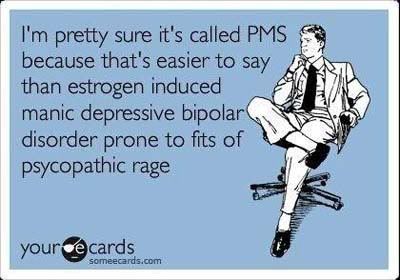Research has found that hormone levels are normal* in PMDD sufferers but their brains are abnormally sensitive to monthly fluctuations in hormone levels, and this affects neurotransmitter levels. It is not well understood though. Serotonin and GABA seem to be the two neurotransmitters that are implicated in PMS. Serotonin is the "happy hormone" that increases when SSRIs are taken. Serotonin levels seem to go up and down with oestrogen levels in women with PMDD.
*Recent research may have shown that although total oestrogen is the same between PMDD patients and controls, 'Free' oestrogen is lower in PMDD patients. The rest is bound to SHBG which is higher in PMDD patients, and therefore not available for use by body. This was the result of this large study:
http://jcem.endojournals.org/content/93/1/96.full
GABA is a sedating, calming neurotransmitter. It is made in the brain from the neurosteroid allopregnanolone, which is manufactured in the body from progesterone. Allopregnanolone also increases when you drink alcohol, which is why women find alcohol more sedating than men.
Progesterone and its metabolites result in increased relaxation and reduced anxiety in a way that is similar to the effects of benzodiazepines by a direct effect on neurotransmitter receptors called Gamma-AminoButyric Acid type A (GABAA) receptors. When progesterone levels drop a woman can experience withdrawals similar to the withdrawal seen with benzodiazepine, barbiturate, and alcohol withdrawal.
Currently, neither PMS nor PMDD are reflected as official diagnoses by DSM-IV. PMDD appears as a "depressive disorder not otherwise specified."
In the DSM-IV, the criteria are as follows:
"In most menstrual cycles during the past year, symptoms (e.g., markedly depressed mood, marked anxiety, marked affective lability, decreased interest in activities) regularly occurred during the last week of the luteal phase (and remitted within a few days of the onset of menses). These symptoms must be severe enough to markedly interfere with work, school, or unusual activities and be entirely absent for at least 1 week post menses" (American Psychiatric Association [DSM-IV-TR], 2000).
According the American Psychiatric Association's website, the new proposed changes would actually recognize PMDD as a disorder. The criteria would be as follows:
A. In most menstrual cycles during the past year, five (or more) of the following symptoms occurred during the final week before the onset of menses, started to improve within a few days after the onset of menses, and were minimal or absent in the week postmenses, with at least one of the symptoms being either (1), (2), (3), or (4):
(1) marked affective lability (e.g., mood swings; feeling suddenly sad or tearful or increased sensitivity to rejection
(2) marked irritability or anger or increased interpersonal conflicts
(3) markedly depressed mood, feelings of hopelessness, or self-deprecating thoughts
(4) marked anxiety, tension, feelings of being "keyed up" or "on edge"
(5) decreased interest in usual activities (e.g., work, school, friends, hobbies)
(6) subjective sense of difficulty in concentration
(7) lethargy, easily fatigued, or marked lack of energy
(8) marked change in appetite, overeating, or specific food cravings
(9) hypersomnia or insomnia
(10) a subjective sense of being overwhelmed or out of control
(11) other physical symptoms such as breast tenderness or swelling, joint or muscle pain, a sensation of "bloating," weight gain
B. The symptoms are associated with clinically significant distress or interferences with work, school, usual social activities or relationships with others (e.g. avoidance of social activities, decreased productivity and efficiency at work, school or home).
C. The disturbance is not merely an exacerbation of the symptoms of another disorder, such as Major Depressive Disorder, Panic Disorder, Dysthymic Disorder, or a Personality Disorder (although it may be superimposed on any of these disorders).
D. Criteria A, B, and C should be confirmed by prospective daily ratings during at least two symptomatic cycles. (The diagnosis may be made provisionally prior to this confirmation.)
E. The symptoms are not due to the direct physiological effects of a substance (e.g., a drug of abuse, a medication or other treatment) or a general medical condition (e.g., hyperthyroidism).
F. In oral contraceptives users, a diagnosis of Premenstrual Dysphoric Disorder should not be made unless the premenstrual symptoms are reported to be present, and as severe, when the woman is not taking the oral contraceptive.
Hormones and depression
On the name 'PMDD' (Professor Studd is a UK specialist on hormones and PMDD)
Women are much more likely to suffer from depression than men, because of our hormones but it is important to rule out other conditions before self-diagnosing with PMDD, especially if your symptoms are severe.
“A thorough physical exam including gynecological examination is recommended in the assessment of all women being evaluated for PMS. Organic causes of PMS-like symptoms must be ruled out. Marked fatigue may result from anemia, leukemia, hypothyroidism, or diuretic-induced potassium deficiency. Headaches may be due to intracranial lesions. Women attending PMS clinics have been found to have brain tumours, anemia, leukemia, thyroid dysfunction, gastrointestinal disorders, pelvic tumours including endometriosis, and other recurrent premenstrual phenomena such as arthritis, asthma, epilepsy, and pneumothorax.” taken from Clinical Reproductive Medicine and Surgery
Other conditions that may cause PMDD symptoms: atypical hyperplasia, polycystic ovaries, adenomyosis, fibroids.
photo credit: Kimberly Gauthier | Keep the Tail Wagging via photopin cc


No comments:
Post a Comment